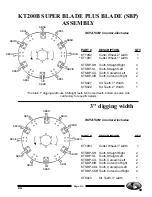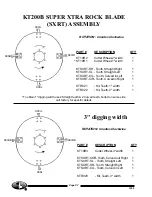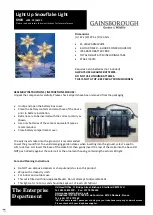
0798
Page O-7
R
MAINTENANCE CONT...
V-BELT CARE:
V-belts may be the item most overlooked during equipment maintenance, but proper care and
maintenance of V-belts and their sheaves (pulleys) can yield great rewards. The nature of V-
belts makes preventive maintenance relatively easy. V-belts and sheaves wear gradually and
usually give advance warning of failure.
Nonetheless, it is important to recognize the warnings. All belts and sheaves will wear as part of
their lifes cycle. As wear occurs, the belts will ride lower in the grooves. A worn belt is, in effect,
longer than a new one.
V-belts grip by wedging in the pulley grooves. Belts that are too loose cause slippage, loss of
power, loss of speed and rapid wear to both the belt and the sheave. A howl or squeal indicates
that the belt is too loose or the load is too heavy.
ALIGNMENT AND TENSION:
Check to be sure sheaves are properly aligned because misalignment can cause excessive
wear to the belt sidewall. Unusual wear of the belt outer cover is an indication of more serious
mechanical trouble. V-belts are designed to operate by making clean, dry surface contact with
the sidewall of the sheaves. Inspect belts periodically to assure that they are not contaminated
with grease or oil. Don't allow mud, rust or any other foreign matter to build up in sheave grooves.
Clean sheaves carefully with a wire brush.
SIGNS OF TROUBLE:
Don't install new V-belts without carefully inspecting the sheaves. Focus special attention on
these conditions: ~ worn groove sidewalls ~ a shiny sheave groove bottom ~ wobbling sheaves
or ~ damaged sheaves. Sheave sidewalls must be perfectly straight because the wedging ac-
tion of the V-belt is impaired and its gripping power is reduced when the walls are worn or dished
out. A shiny sheave groove bottom is an indication that the belt, sheave or both are badly worn
and the belt is bottoming in the groove. This condition may first be evident on the smaller sheave.
Sheave wobble may be caused by ~ improper installation on the shaft ~ a worn/damaged bush-
ing ~ a worn/damaged sheave hub or by ~ a bent shaft. Any of these conditions will cause early
failure. The wobbling
sheave whips the belt
from side to side,
subjecting the belt to
lateral strain and causing
rapid wear to both the
sheave and belt. Vibration
is another indication of an
improperly installed or
damaged sheave; however,
vibration can also be caused by a damaged belt.
Summary of Contents for Kwik-Trench KT200B
Page 11: ...PARTS INFORMATION NOTES ...






































